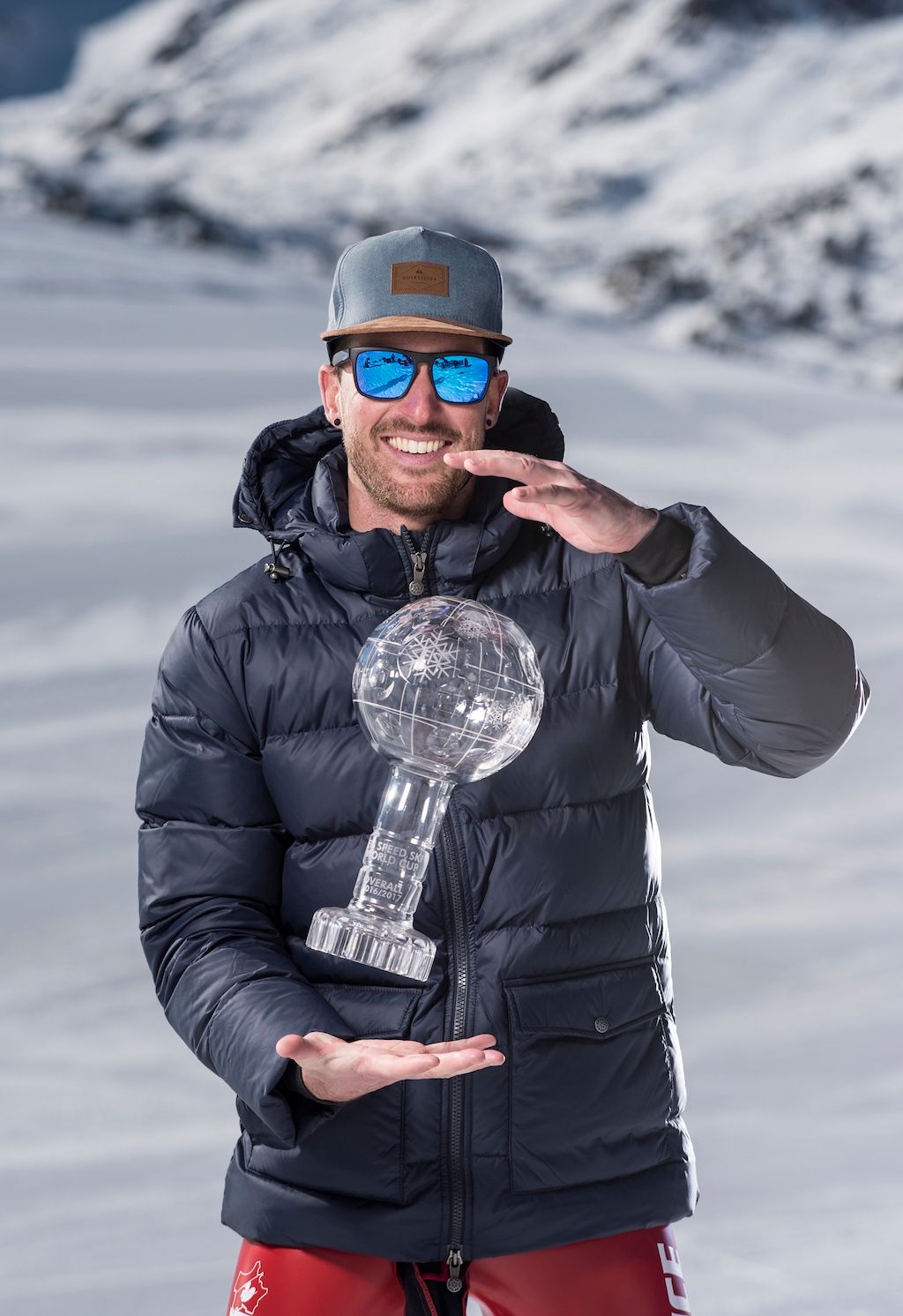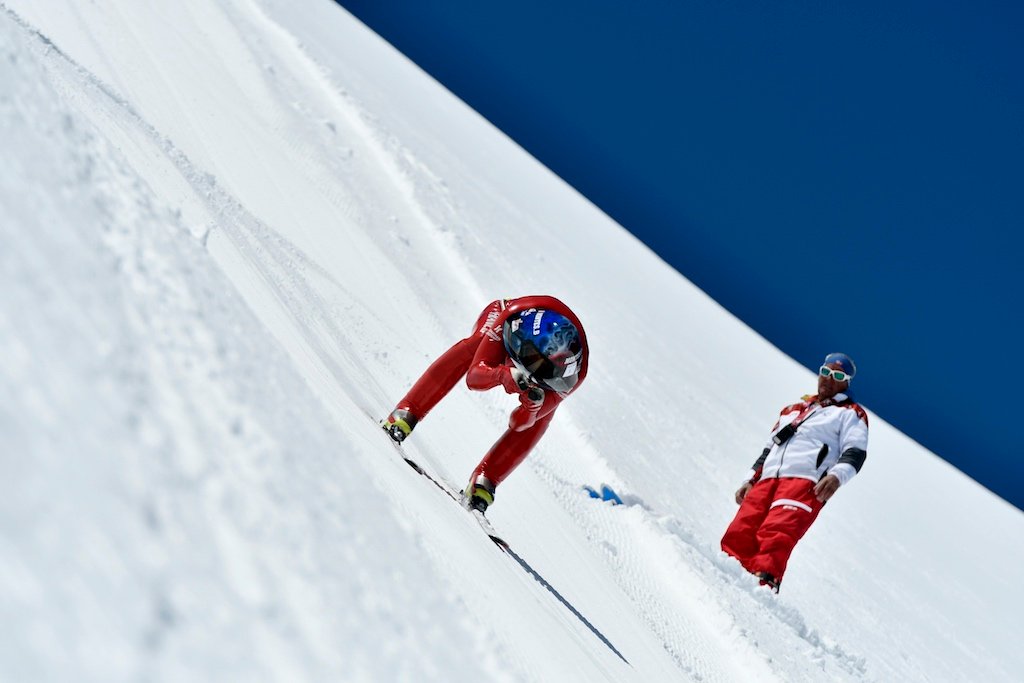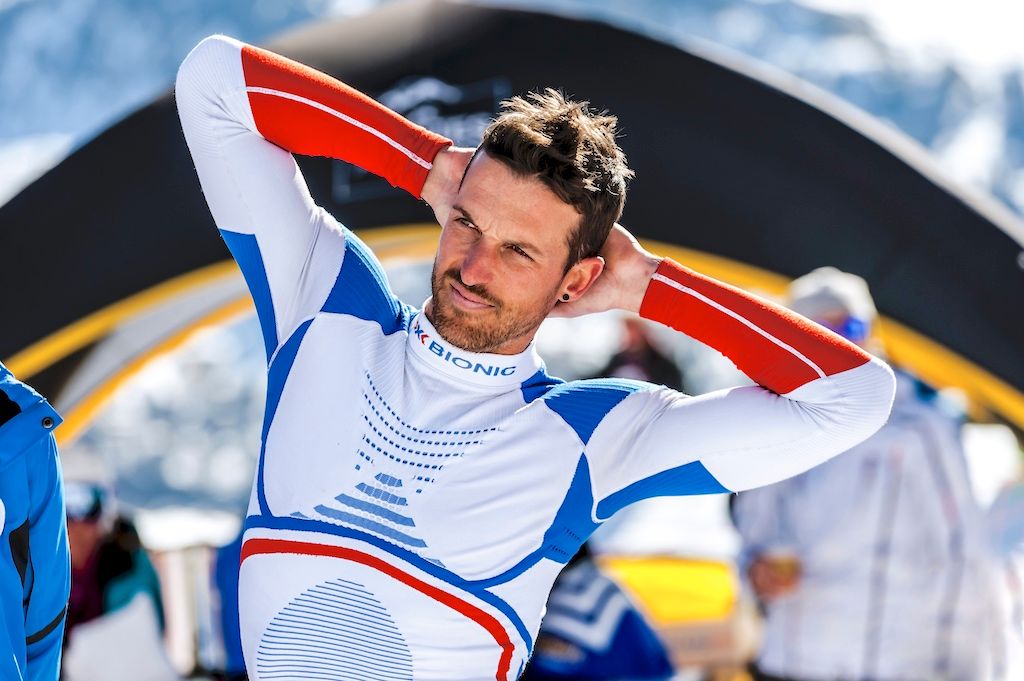Bastien Montès
Bastien Montès interview: “Skiers regularly refuse the start of races at high speeds, paralyzed by the stake, by the risks.”
The fastest man in the world this year talks about the psychological edge needed to hurl yourself down a mountain at twice the national speed limit, and explains what’s so special about the Chabrieres speed ski track in Vars, France.
“We go from 0 to 200 km/h in less than 6 seconds.”
Bastien Montès has good reason to smile. On 2nd April the French speed skier clocked 233.161 km/h (144.88mph) – the fastest speed of the season – to win his second Speed Masters tournament in a row here in Vars.
Take a look at his World Cup results, in which Bastien finished 3rd overall, add last year’s World Championship title, and you have the makings of an athlete relatively content with his place on the mountain.
Okay so his World Cup results might have been a couple of places higher in an ideal world, but for Bastien the focus this year was not on trophies but breaking records. On edging past that elusive 254.958 km/h (158.424 mph) set by Ivan Origone here in 2016. All speed skiing is fast, but if you’re going to go faster, if you’re going to go fastest, the Speed Masters tournament in Vars is the only place to do it. If you’ve got the nerve.

“Speed Masters are always a moment apart,” Bastien says. “This is the world’s most impressive track, the fastest in the world. Only the ten best skiers in the world are qualified – it’s the grail in our discipline.”
It’s certainly the grail in Bastien’s, because for the past two years Speed Masters is an event he has ruled. Last year he rocketed to victory “just after winning the World Championship – at the return of one year and a half without skiing, following a rupture of the ACL. It was a dream come true. 251 km/h, what a feat!”
When Bastien talks of the Chabrieres track here in Vars it’s not difficult to infer his impression of something that’s more than just a sports venue. Granted it’s a stop-off on the World Cup circuit (one of eleven stages) but such are the characteristics of this near-sheer slope that it has been elevated to the status of speed skiing eminence, a supreme track where everything takes the superlative form. When you’re standing at the bottom, it towers over you like a cliff-face until you feel your head spin and your knees weaken. Given that only ten professionals are allowed to race here every year, it’s daunting even for someone who’s used to soaring down steep slopes in the fastest non-motorised form of transport on earth. But for Bastien, if it’s frightening, it’s also thrilling, an arena he views with something like adulation.
His exposition of the Chabrieres track is eyebrow-raising.
“Ninety-eight percent slope,” Bastien says. “1.4 km of track swallowed in less than twenty seconds. We go from 0 to 200 km/h in less than six seconds, this is an acceleration higher than Formula 1. It’s a whole slice of mountain that is exploited. It’s the track! Moreover, the one that I grew up on, the one that gave me my first records, the one of my greatest victories, the one I hope for my next world record. In World Cup, many tracks are shorter, less sloping, and therefore slower. Only four tracks in the world currently allow us to exceed 200 km/h.”
From personal experience I know that 75mph (120 km/h) on skis is a crazy sensation where the passing airflow rises to a roar and your standard-issue goggles and helmet start to lift back alarmingly over your face and head. But double that speed? It’s not just unnatural – it’s as alien as those flared helmets and neoprene suits and wing-like foam leg fairings. How does a human cope at these limits?

“Speed skiing is an extreme sport of precision,” Bastien says. “Many hours of preparation are needed for just twenty seconds of a crazy race. A race day always begins with an update with the technicians who take care of our skis. They are real goldsmiths. The ski is chosen according to the conditions of the moment and the sensations of the pilot. A debriefing is done in the early morning to choose together the final “secret potions” that will be used for the day. He has already spent eight hours preparing your skis during the night…
“Then muscular awakening is needed – a mixture of yoga positions and dynamic activation to numb the body. A breakfast to refuel, and start a preparation of more than two hours with the help of an outside person to don the equipment and perfect its aerodynamics.
“Finally it is the arrival on the track and the first marks of lines, holes, bumps – each centimetre is scrutinized. Taking snow temperatures, then this is the beginning of a long period of concentration; apprehension is inevitably present at the start of such an extreme race but we must learn to use it positively, to exploit it for to be stronger and not to fall into fear.” For a speed skier, failing to manage that apprehension comes at a cost. “Skiers regularly refuse the start of races at high speeds, paralyzed by the stake, by the risks, scars of old falls etched forever on our bodies.”
I swallow, and while I’m wondering if it’s something I’ll ever steel myself to try (because here in Vars the regular skiing public are allowed to have a go, albeit from a much lower starting position), Bastien adds casually, “The rest of the day is filled with happiness, intense feelings, sharing.”
So that’s fine then.
What’s hard to grasp for someone not addicted to velocity is Bastien’s acute focus on speed. It is his idol, it is a whole part of his life measured in km/h. And speed in its purest form is more precious to him than trophies or podium placings.
“This year I decided to focus only on the Speed Masters, to be 200% on the day, to try to get a world record, even to set aside for a season the overall classification of the World Cup: 11 stages.” His fixation nearly paid off. “A new win, and the fastest men’s title of the year for the second consecutive season shows that I am currently the strongest at high speed. But unfortunately no world record.”

That goal was taken out of Bastien’s hands by mother nature. If the snow conditions felt variable to me as I meandered my way around the pistes of Vars, they must have been wildly unpredictable for such precision athletes. In any case, the world record was never under threat.
“The track was considered too dangerous by the organizers to start from its summit. It’s a decision that I respect,” he says, but adds, “I was largely able, I was specially prepared for that. I’m inevitably disappointed.”
It’s the threat of anti-climax, it seems, that gives courage to these elite racers who are the fastest of the fast. But that’s not enough to send most of us to the top of the mountain, side-stepping gingerly across to a drop that’s as good as vertical, and then turning our skis to point straight down. What’s important to realise is that speed skiers, like big air snowboarders and large hill ski jumpers, have evolved into their current forms. There’s no sudden urge to throw yourself off a mountain. Like women’s world record holder Valentina Greggio, Bastien has been skiing in some form or other almost since he could walk.
“I started skiing at the age of two, at the same time I was a top athlete in gymnastics until I was fourteen, and of course freestyler and freerider for the brand Quiksilver since I was eight years old. I have always practiced skiing on the Super G and the downhill but my dreams were more extreme, more about freedom.
“In 1992 my father was coach of the French team at the Albertville Olympic Games, and I discovered from inside the discipline that is speed skiing. My sponsors, Quiksilver decided to create a challenge for 6-16 years, allowing the youngest to reach 70 km/h and the largest 170! The virus was taken: I never left my profiled helmet and my long skis, in parallel with some freeride shooting sessions for the brand.”

Among all those trophies, medals, a national record even – notched up over the years with near-inevitability, Bastien’s most treasured memory as a speed skier is one of sentimentality, a gesture towards his father who passed away in 2014.
“To have shone my father’s eyes when he was still at my side, my first world medal in the overall category, in 2007 in Verbier, Switzerland. A crazy race, an incredible result, almost unexpected, that he could only have imagined in his wildest dreams.”
If sheer speed is venerated more highly than trophies, then Bastien’s feelings for his late father are held in higher regard still. Perhaps it’s an emotional perspective which acts as the tonic to his fear. Perhaps Bastien can tackle Chabrieres because he knows he’s found success when it mattered most. Not that such wisdom has given him an easy ride.
Scroll through the images on his official website and you’ll see a career beset with injuries – of hospital bed selfies, of knees strapped and criss-crossed with tape. What it comes down to is how, as a performer, those setbacks are faced.
“Never let go,” is Bastien’s advice. “All high-level athletes know at one time or another the failure, the injury, the bad self-esteem, the wish to give up. But it is in these moments that the greatest victories are built. By searching deep inside of previously unknown resources, [you find] the engine of future great things. It is these bouncing athletes who become the most formidable.”

My grateful thanks to Bastien for finding some time in his hectic schedule to talk to me. You can find out more about this year’s fastest man in the world at the following:
Bastien Montès Website: www.bastienmontes.com
Bastien Montès Facebook: /bastmontes
Bastien Montès Twitter: @bast_montes
Bastien Montès Instagram: @bast_montes
Related article: Valentina Greggio
